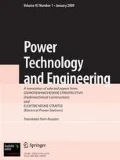A significant temperature difference between the central zone and the surface of a structure can occur because of the heat generation in cement when making mass concrete. This leads to the formation of tensile stresses and thermal cracks. One of the technological measures to eliminate this adverse effect is to use surface thermal insulation. It can be used both in winter (to prevent excessive cooling of the concrete surface) and in summer (to reduce surface heating). The finite-element method is used to evaluate the effect of the type and thickness of the thermal insulation on the horizontal surface on the temperature regime of the mass concrete. A technique of determining the thickness of surface thermal insulation (polystyrene foam or sand layer) necessary for certain construction conditions is proposed. The results obtained can be used in the design and construction of large concrete blocks.
Similar content being viewed by others
References
E. P. Onyekachukwu, P. Sharma, and J. Singh, “Review work on plastic formwork,” Int. J. Civil Eng. Technol., 8(7), 1441 – 1146 (2017).
N. A. Aniskin and N. T. Chuc, “Problem of thermal cracking in concrete gravity dams,” Vestn. MGSU, 15(3), 380 – 398 (2020).
N. T. Chuc, P. V. Thoan, and B. A. Kiet, “The effects of insulation thickness on temperature field and evaluating cracking in the mass concrete,” Electronic J. Struct. Eng., 18(2), 128 – 132 (2018).
B. A. Krylov, “Some issues of cold whether concrete construction,” Tekhnol. Betonov, No. 1, 33 – 35 (2012).
K. V. Semenov and Yu. G. Barabanshchikov, “Thermal crack resistance of massive concrete foundation slabs in winter construction period,” Stroit. Unik. Zdanii Sooruzh., 17(2), 125 – 135 (2014).
N. A. Aniskin, N. T. Chuc, I. A. Bryanskii, and D. H. Hung, “Determination of the temperature field and thermostressed state of stacked concrete by the finite-element method,” Vestn. MGSU, 13[11(122)], 1407 – 1418 (2018).
Yuan-Yuan Chen, Ssu-Yu Chen, Chien-Jou Yang, and Hei-Tao Chen, “Effects of insulation materials on mass concrete with Pozzolans,” Constr. Build. Mater., 137, 261 – 271 (2017).
Specification for Structure Concrete, ACI Committee 301 – 10, American Concrete Institute, Farmington Hills, MI (2010).
Rules and Regulations SP 41.13330.2012. Concrete and Reinforced Concrete Hydraulic Structures [in Russian].
T. Yu. Krat and T. N. Rukavishnikov, “Assessment of the temperature regime and thermostressed state of spillway blocks in various construction conditions,” Izv. VNIIG, 248, 77 – 85 (2007).
Zhu Bofang, Thermal Stresses and Temperature Control of Mass Concrete, Elsevier (2014).
X. Zhang, S. Li, Y. Li, Y. Ge, and H. Li, “Effect of superficial insulation on roller-compacted concrete dams in cold regions,” Adv. Eng. Software, 42(11), 939 – 943 (2018).
S. Whittier, J. Olyniec, and R. Mcglohn, “Minimizing temperature differentials in mass concrete,” Concrete Int. (2004).
ACI 207.4R-93. Cooling and Insulating Systems for Mass Concrete, American Concrete Institute, Farmington Hills, MI (1993).
T. C. Nguyen and X. B. Luu, “Reducing temperature difference in mass concrete by surface insulation,” Magaz. Civil Eng., 88(4), 70 – 79 (2019).
K. K. Ki, E. I. Gwan, and K. M. Gug, “Adiabatic temperature rise and reaction rate of mass structure in Lotte Center Hanoi project,” J. Sci. Technol. Build. (2012).
J. Sun, Y. Pang, and W. Zhao, “FEM analysis of massive concrete pile using of cooling pipe in shahe bridge,” Appl. Mech. Mater., 501 – 504, 1359 – 1363 (2014).
X. Liu, Y. Yuan, and Q. Su, “Sensitivity analysis of the earlyage cracking risk in an immersed tunnel,” Struct. Concrete, 15(2), 179 – 190 (2014).
J. Se-Jin, “Advanced assessment of cracking due to heat of hydration and internal restraint,” ACI Mater. J., 105, 325 – 333 (2008).
Soo Geun Kim, Effect of Heat Generation from Cement Hydration on Mass Concrete Placement. Graduate Theses and Dissertations (2010).
Author information
Authors and Affiliations
Corresponding author
Additional information
Translated from Gidrotekhnicheskoe Stroitel’svo, No. 11, November 2020, pp. 4 – 11.
Rights and permissions
About this article
Cite this article
Aniskin, N.A., Chuc, N.T. & Khanh, P.K. The Use of Surface Thermal Insulation to Regulate the Temperature Regime of a Mass Concrete During Construction. Power Technol Eng 55, 1–7 (2021). https://doi.org/10.1007/s10749-021-01310-6
Published:
Issue Date:
DOI: https://doi.org/10.1007/s10749-021-01310-6




